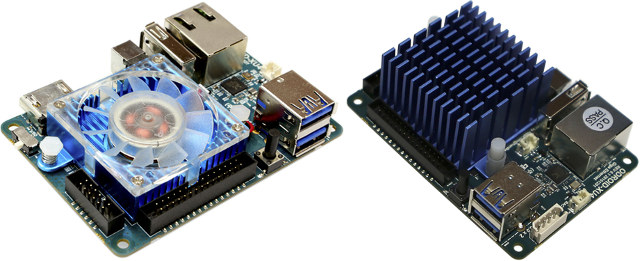[Update May 2018: You may be interested in ODROID-XU4Q review with Ubuntu 18.04]
We had already seen ODROID-XU4 development board price drop to $59 earlier this year, but a frequent complain about the board remained: it requires a fan to operate at full speed, and makes noise while the fan turns. To address this issue, the company has now launched ODROID-XU4Q board with exactly the same specifications with Samsung Exynos 5422 octa-core processor, 2GB RAM, eMMC module support, Gigabit Ethernet, USB 3.0, HDMI 1.4 etc…, except the fan is replaced by a large heatsink.

The company has also thoroughly tested both versions in different configurations such as setting the maximum frequency to 1.8 or 2.0 GHz, and found ODROID-XU4Q to be slightly slower under high load due to CPU throttling, as the large heatsink does not cool quite as well as the smaller heatsink in combination with a fan. However in many cases, the difference is minimal as shown by Antutu results (61,112 vs 60,283 points). Running sysbench at 2.0 GHz showed one of the biggest gaps in performance, with XU4Q taking 16% more time (420 seconds vs 362 seconds) to complete the test as shown below.

If you run the board at 1.8 GHz, the difference decreases to just 6%. If you are using ODROID-XU4 as part of a build farm, you may want to keep using the actively cooled version, it takes take 25 minutes to build the Linux kernel against 30 minutes on ODROID-XU4Q.The company also found that if you don’t want throttling at all, you need to set the CPU frequency to 1.2 GHz.
The company also had to add a cut out line to ODROID-XU4(Q) cases to allow for the taller heatsink. If you have a ODROID-XU4 board with a fan, and would like to convert it into a quitet ODROID-XU4Q board, you can do so by purchasing a similar (but not exactly the same) heatsink for $4.90 + shipping. The price for ODROID-XU4Q board is the same as for ODROID-XU4 ($59 + shipping).
If you’re wondering when the next major update of ODROID board is coming, there is a clue in ODROID Magazine April 2017:
In 2017, we are planning another 64-bit ARM platform and a 64-bit x86 platform, and we are also considering an upgraded version of XU4.

Jean-Luc started CNX Software in 2010 as a part-time endeavor, before quitting his job as a software engineering manager, and starting to write daily news, and reviews full time later in 2011.
Support CNX Software! Donate via cryptocurrencies, become a Patron on Patreon, or purchase goods on Amazon or Aliexpress





cnxsoft : if you don’t want throttling at all, you need to set the CPU frequency to 1.2 GHz Strange idea. Just set 2.0GHz and let throttling do the job so you’re able to enjoy maximum peak performance and only if temperatures increase too much (this stuff is accessible through sysfs!) let the kernel throttle CPU cores. This can even result in lower overall consumption since when the CPU cores finish stuff in less time they can enter low power states also earlier (race to idle). And on the XU4 with the big.LITTLE SoC it works surprisingly well to push… Read more »
If you checkout the latest Odroid magazine there are 3D print files for a nice little 2 layer case that accommodates a nocta fan (and heatsink v.similar to this) … I got a gigabyte passively cooled brix sometime ago which ran really hot 24/7 .. I just rested it on a quiet 12v fan (run at 5V via USB connector) and now silent and cool ..BUT the fan does need a flick to start spinning from off
In that case it helps powering the fan by 7V (between red and yellow wire) it will still be quiet but most fans start reliably with 7V.
The trouble here is that most fan and heat sink coolers take their design from INTEL and AMD monsters.
Looking more how fan less graphics cards or quiet fan graphic cards work gives better solutions.
You can even learn from American ground squirrels ! ( Prairie dog ). It is all about Air flow and surface area.
https://asknature.org/strategy/asymmetric-burrow-openings-create-passive-ventilation/#.WQG-FhXTUb0
@Theguyuk
If I understand that article correctly ground squirrels build the entrance of their tunnels with a slight angle in order to direct wind inside their tunnel to refresh the air.
I’m not sure how this can be applied to fanless system and heatsink, since it requires wind, something that lacks indoors…
@Jean-Luc Aufranc (CNXSoft)
When there’s no airflow you can only benefit from warm air ascending. And then all you need is a quick google search for ‘heat sink fin spacing natural convection’ and some time to read 😉
But even if fin distance is too close you don’t need an annoying fansink but just one large (read as: slow/silent) fan responsible for some ventilation. The difference is amazing.
Odroid has sold the passive heatsink as a stand alone item for a while now. wonder what made them now sell it preconfigured
While the XU4Q heatsink looks the same it’s not, the fins are thinner than the heatsink you linked. At least originally, maybe now they are the same…not sure since I have an XU4Q and the original blue heatsink I was sent to test more than a year ago.
@Dsl
they need buzz to sell the last units!!! As the Odroid magazine says they prepare 3 new board for this year!!!
Looks like there’s no x86 platform from hardkernel this year.
how can i buy the ODROID-XU4 on $59 now?